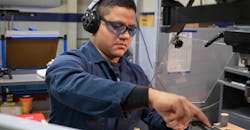America's Safest Companies 2018: Lockheed Martin Missiles and Fire Control
Lockheed Martin Missiles and Fire Control (MFC) is experiencing a period of "unprecedented growth," and that brings challenges across the business in terms of staffing, resources and facilities, says EHS manager Casey Anderson.
Even through all the many changes, MFC maintains its commitment to excellence, respecting others and a clear focus on its customers' missions.
"MFC's approach to safety, employee engagement and management involvement separates us from our peers," Anderson says. "Our leadership and employees are committed to developing and evolving effective, customer-focused EHS systems and processes that improve and sustain performance while enhancing engagement of all parties and developing professional talent."
Workers at Lockheed Martin are encouraged to participate through:
Production Management Teams. The cornerstone of employee engagement at MFC, these employee-centric teams are empowered to create workplace safety improvements, deliver value to the customer and strengthen the company's competitive edge. Teams meet once per week for an hour and are comprised of employees from various work areas and facilitated by EHS, Engineering and Leadership representatives to help the teams improve their work areas and find the "yes" in their recommendations.
Union Safety Committee. This collaboration of represented employees and non-represented employees serves to improve workplace safety. The purpose is to collaborate as one team for injury prevention.
Close Calls (Hazard Reporting). The close call process is a reporting system where employees can communicate the hazards they encounter that could result in an injury or property damage. This process involves an investigation, identification of causes, corrective actions, review to determine if other areas are affected, and lessons learned communications.
Leadership understands and promotes the successful execution of key tenets, namely: safety, security, quality, schedule and cost.
"MFC leadership recognizes that our work environments are complex and dynamic and is dedicated to approaching challenges and opportunities with innovation and integrity," Anderson says.
About the Author

Dave Blanchard
Editor-in-Chief / Senior Director of Content
During his career Dave Blanchard has led the editorial management of many of Endeavor Business Media's best-known brands, including IndustryWeek, EHS Today, Material Handling & Logistics, Logistics Today, Supply Chain Technology News, and Business Finance. In addition, he serves as senior content director of the annual Safety Leadership Conference. With over 30 years of B2B media experience, Dave literally wrote the book on supply chain management, Supply Chain Management Best Practices (John Wiley & Sons, 2021), which has been translated into several languages and is currently in its third edition. Prior to joining Endeavor/Informa/Penton, he spent a decade covering the artificial intelligence industry. He is a frequent speaker and moderator at major trade shows and conferences, and has won numerous awards for writing and editing. He is a voting member of the jury of the Logistics Hall of Fame, and is a graduate of Northern Illinois University.

